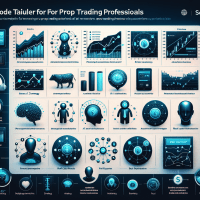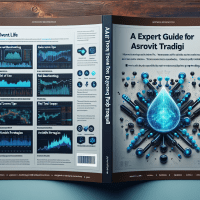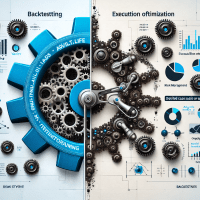Introduction: The Evolving Role of AI in Prop Trading
Prop trading is continually reshaped by advancements in technology, and artificial intelligence has emerged as a critical component. Today, we compare two cutting-edge tools: Solvent.Life vs Vantir – AI strategy vs AI feedback models. This comprehensive guide is designed for prop trading professionals ranging from junior traders to senior quants and risk managers. We dive deep into automated backtesting frameworks, advanced risk management practices, and regulatory compliance to empower you with the insights needed to excel in a competitive market.
In this article, you will learn practical tips for using advanced backtesting methods and integrating AI driven strategies into your trading operations. We analyze the features of leading tools, share real-world case studies, and provide detailed comparisons to help you choose the best solutions for your prop trading firm.
Understanding the Comparison: Solvent.Life vs Vantir
With prop trading becoming data-intensive, selecting the right AI model can significantly impact your trading performance. Our primary focus here is on comparing the AI strategy of Solvent.Life with the AI feedback models offered by Vantir.
Overview of Solvent.Life
Solvent.Life is designed for prop firms and individual traders looking for a robust AI strategy framework. It offers:
- Automated backtesting features using both vectorized and event-driven methods.
- Deep historical data archives covering multiple asset classes.
- Seamless integration with popular trading platforms such as MetaTrader 5 and NinjaTrader via API access, ideal for team collaborations.
- Advanced optimization capabilities with automated parameter tuning and scenario analysis.
- Flexible pricing tiers with free trial options, making it accessible to both retail and institutional users.
Overview of Vantir
Vantir, on the other hand, emphasizes AI feedback models that adapt and learn from live trading data. Key highlights include:
- Robust backtesting automation that includes stress testing and walk-forward analysis.
- Real-time data feeds ensuring up-to-date market conditions are factored into model training.
- Integration capabilities with platforms such as TradingView and Interactive Brokers for seamless broker execution.
- Comprehensive risk management tools integrating commission and slippage adjustments.
- Customizable pricing packages suitable for larger teams and prop firm environments.
Figure 1: A detailed backtesting report interface from NinjaTrader illustrating key performance metrics for prop trading strategies.
Advanced Backtesting Techniques in Prop Trading
Proper backtesting is an indispensable tool for validating trading strategies before live execution. However, the process is fraught with pitfalls such as overfitting, survivorship bias, look-ahead bias, and data snooping. Here are key strategies to enhance your backtesting processes:
Mitigating Common Backtesting Pitfalls
- Overfitting: Ensure your strategy is robust by using out-of-sample data and cross-validation techniques.
- Survivorship Bias: Incorporate historical data that includes delisted or failed assets to obtain a realistic performance estimate.
- Look-Ahead Bias: Maintain strict separation of training and testing datasets to avoid using future information in your algorithms.
- Data Snooping: Use multiple testing iterations and parameter optimization with caution to prevent overly selective tuning.
Walk-Forward Optimization vs. Traditional Backtesting
The conventional backtesting approach merely tests a strategy on historical data sets; walk-forward optimization pushes analysis further by continuously validating the model on out-of-sample data. This technique provides a more realistic gauge of a strategy’s performance as market conditions shift over time. Traders should:
- Break data into training and testing segments iteratively.
- Optimize parameters based on the training segment and validate with the next period’s data.
- Record performance metrics such as Sharpe ratios, maximum drawdown, and profit factors during each segment.
Integrating Backtesting with Forward Testing
Before a strategy can be executed live, it must also pass paper trading or forward testing phases. This integration ensures that the backtesting results are consistent with real market conditions. Common key metrics during forward testing include:
- Sharpe ratio targets above 1.5 indicating risk-adjusted performance.
- Maximum drawdown limits maintained below 20% to control risks.
- Profit factor expectations generally exceeding 1.25 for operational sustainability.
Sample Python Code for Automated Backtesting with Backtrader
import backtrader as bt
class TestStrategy(bt.Strategy):
def __init__(self):
self.sma = bt.indicators.SimpleMovingAverage(period=15)
def next(self):
if self.data.close[0] > self.sma[0] and not self.position:
self.buy(size=100)
elif self.data.close[0] < self.sma[0] and self.position:
self.close()
cerebro = bt.Cerebro()
# Add data feed and strategy
# cerebro.adddata(data)
cerebro.addstrategy(TestStrategy)
result = cerebro.run()
print('Final Portfolio Value: %.2f' % cerebro.broker.getvalue())
Practical Risk Management and Compliance in Prop Trading
Risk management remains paramount for sustaining profitable prop trading. The implementation of AI models like those offered by Solvent.Life and Vantir helps in setting risk controls while complying with regulatory frameworks.
Regulatory Considerations:
- MiFID II & ESMA Regulations: Ensure trading algorithms adhere to data transparency and reporting obligations.
- NFA Rules: Maintain stringent risk management protocols to meet regulatory standards, especially relevant for U.S.-based prop firms.
- Internal Compliance: Regular audits and stress testing are critical to ensuring the integrity of automated backtesting frameworks.
Many firms harness tools like TradingView for real-time risk analytics, while others integrate with MetaTrader 5 for detailed commission and slippage adjustments.
Figure 2: An example risk management dashboard from TradingView highlighting drawdown and Sharpe ratio.
Case Studies: Real World Application in Prop Trading Firms
Many established prop trading firms have successfully integrated AI models and automated backtesting tools to optimize their trading strategies. For instance:
Case Study: Optimizing Strategy Parameters
A leading prop trading firm implemented Solvent.Life's AI strategy module to refine its algorithmic trading approach. By leveraging automated parameter optimization and scenario analysis, the firm was able to:
- Improve the Sharpe ratio from 1.3 to 1.8 over a six-month period.
- Reduce maximum drawdown by over 15% through more robust risk controls.
- Accelerate the strategy iteration time by 40%, enabling quicker pivots in volatile markets.
Case Study: Feedback-Driven Model Adjustments
Another prominent firm adopted Vantir's AI feedback models to continuously learn from live market dynamics. Facing challenges related to data snooping and overfitting in traditional backtesting environments, the firm found that:
- Walk-forward optimization and out-of-sample validations significantly enhanced model reliability.
- Automated stress testing provided early warnings against market regime shifts.
- Feedback-driven adjustments improved risk management metrics, with a noted profit factor increase from 1.2 to 1.4.
Integrating Internal Resources and Continuous Learning
Integrating these advanced AI tools into your prop trading workflow can be further supported by leveraging internal resources. For example, resources like our Advanced Prop Trading Techniques article and the Risk Management Checklist provide in-depth guidelines to bridge the gap between backtesting and live trading.
Conclusion & Next Steps
Choosing between Solvent.Life and Vantir for your AI-driven trading strategy depends on your specific needs. If you seek an automated parameter optimization and scenario analysis engine, Solvent.Life may be ideal. However, if you require dynamic feedback loops that continuously refine your models in real-time, Vantir is a compelling option.
For those ready to elevate their prop trading game, the next step is clear: integrate robust backtesting strategies and adhere to pragmatic risk management protocols. To further deepen your knowledge, download our comprehensive Risk Management Checklist and join our upcoming webinar on integrating AI into prop trading.
As always, rigorous testing and compliance with regional regulations such as MiFID II, ESMA, and NFA should remain at the forefront of your strategy development, ensuring not only profitability but also operational integrity.
Expert Guidance: In prop trading, the margin for error is slim. Use expert-backed practices and solid data-driven analysis to create a resilient, scalable trading operation. Constant reevaluation and adherence to risk metrics—like maintaining drawdowns below 20% and striving for Sharpe ratios above 1.5—will set you apart in this competitive arena.
Remember, successful prop trading is a journey of continuous improvement and learning. Whether you are a junior trader or a seasoned risk manager, staying informed with the latest tools and techniques is the key to achieving consistent success.







